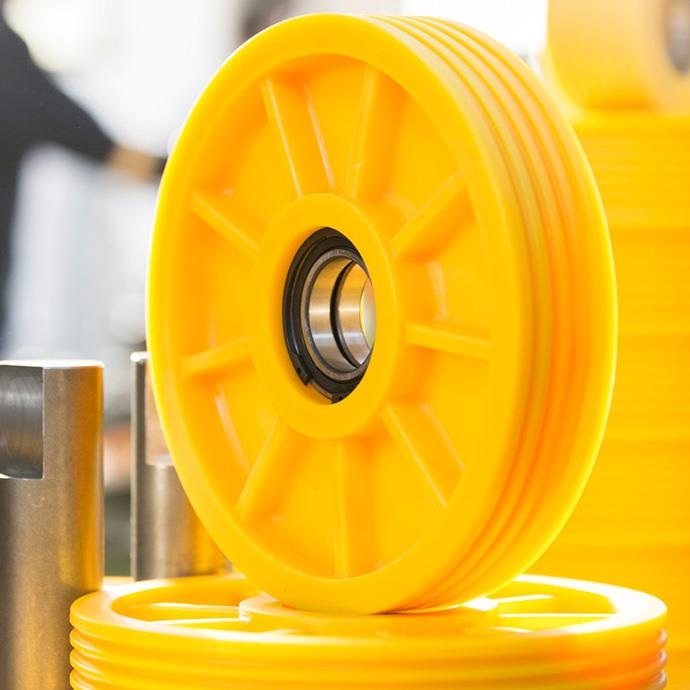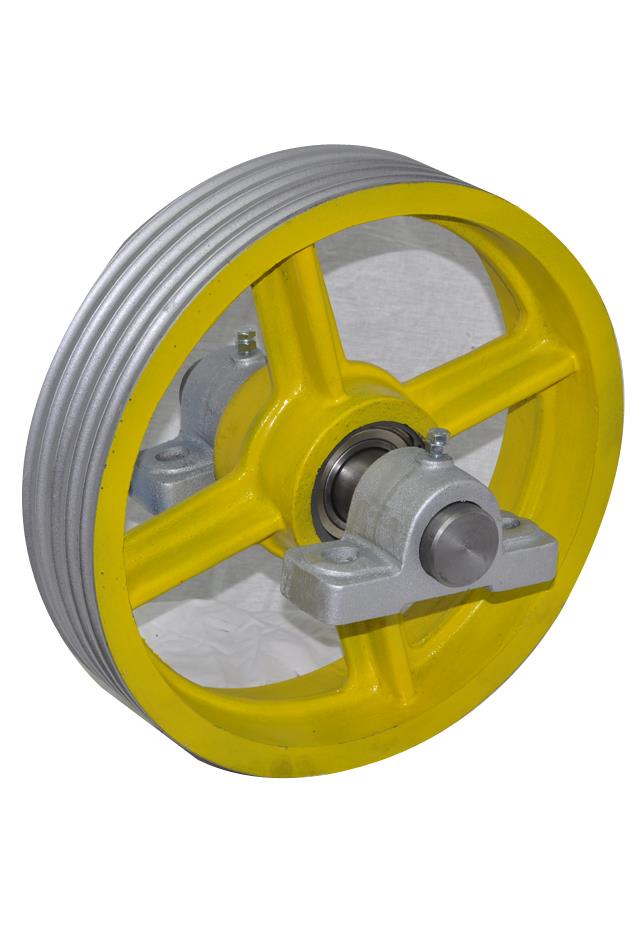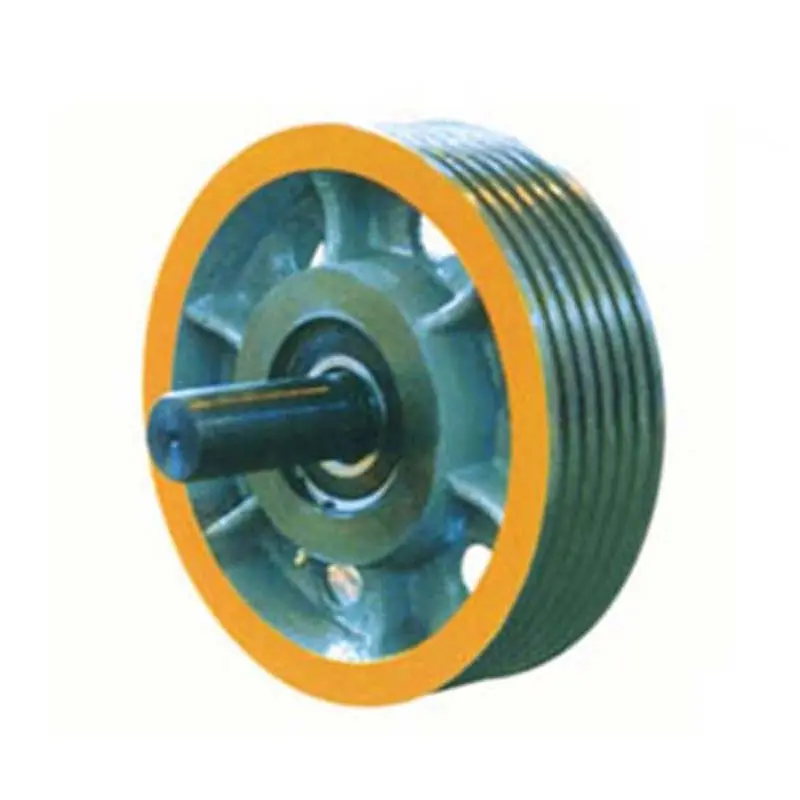Product Description
Hanging Type Cable Block Roller Lifting cable pulley Cable protection pulley block and tackle
Specification
| Item number | Model | Diameter | Width of sheave | Suitable conductor | Rated load (kN) | Weight (kg) | Remark |
| 10171 | SHD-120×30 | 120 | 30 | ACSR25~70 | 5 | 1.5 | Aluminium sheave |
| 10172 | SHD-160×40 | 160 | 40 | ACSR95~120 | 10 | 2.5 | |
| 10173 | SHD-200×40 | 200 | 40 | ACSR150~240 | 15 | 4 | |
| 10174 | SHD-200×60 | 200 | 60 | ACSR150~240 | 15 | 4.6 | |
| 10175 | SHD-250×40 | 250 | 40 | ACSR150~240 | 20 | 4.6 | |
| 10176 | SHD-250×60 | 250 | 60 | ACSR300~400 | 20 | 6 | |
| 10177 | SHD-270×60 | 270 | 60 | ACSR300~400 | 20 | 7 | |
| 10178 | SHD-320×60 | 320 | 60 | ACSR300~400 | 20 | 9.5 | |
| 10179 | SHD-400×80 | 400 | 80 | ACSR400~500 | 20 | 15 | |
| 10191 | SHDN-120×30 | 120 | 30 | ACSR25~70 | 5 | 1.5 | Nylon sheave |
| 10192 | SHDN-160×40 | 160 | 40 | ACSR95~120 | 10 | 2.5 | |
| 10193 | SHDN-200×40 | 200 | 40 | ACSR150~240 | 15 | 3.6 | |
| 10194 | SHDN-200×60 | 200 | 60 | ACSR150~240 | 15 | 4 | |
| 10195 | SHDN-250×40 | 250 | 40 | ACSR150~240 | 20 | 4 | |
| 10196 | SHDN-250×60 | 250 | 60 | ACSR300~400 | 20 | 4.5 | |
| 10197 | SHDN-270×60 | 270 | 60 | ACSR300~400 | 20 | 5.6 | |
| 10198 | SHDN-320×60 | 320 | 60 | ACSR300~400 | 20 | 6.7 | |
| 10199 | SHDN-400×80 | 400 | 80 | ACSR400~500 | 20 | 13 |
ONEREEL is specialized in the design and manufacture Steel Spools, Plastic Spools, Cable roller, Yarn Bobbin, aluminum spool , Cable Reel Stand, Sheave Pulley, Cable Conveyor, Hydraulic Puller Tensioner, Gin Poles, Cable Pulling Winch, Safety Tools, Wire Grip, Plastic Parts, and Pump in the industry since 1991. All of our customer spool and wire carrier are engineered and manufactured in our 120,000 square foot state-of-the-art manufacturing plant located in HangZhou, ZHangZhoug.
ONEREEL is specialized in the manufacture of reels for cables and electric wires, iron axles, disc spool for steel cables and various delivery reels. With strong technological capabilities and full series of production equipment. All of our products go through the dynamic and static balance tests. We have passed the quality system certification ISO9001:2000 to ensure the product quality. Following the standards of GB4004-83, JB/T8997, DIN46395 and DIN46397 in productions.
Hot Product
Our Customer
Packaging & Transportation
Authoritative Certificate
FAQ
Q1: Can I get samples?
A: According to spool model and material, we will advise.
Q2: How long is the sample LEAD TIME?
A: For existing samples, it takes 2-3 days. If no stock, we will advise lead time.
Q3: Can you develop new products?
A: Yes, we have new products developing ability and we are good at developing new mold.
Q4: How much is the freight charge?
A: It depends on spool package volume, if small quantity, volume and urgent goods,
we may advise FEDEX or other couriers’ charge for your check.
If volume bigger and by seaway suitable, we provide FOB or CIF price to you.
Q5: What format of the file do you need if I want my own design?
A: We have our own mound workshop and can provide spool or other plastic product developing and injection service.
Q6: How about your service?
A: We have pre-sale service, in-sale service and after-sale service. As “Customer First” is the most important principle of company operation.
/* March 10, 2571 17:59:20 */!function(){function s(e,r){var a,o={};try{e&&e.split(“,”).forEach(function(e,t){e&&(a=e.match(/(.*?):(.*)$/))&&1
| After-sales Service: | 1year |
|---|---|
| Warranty: | 1year |
| Type: | Hook |
| Material: | Stainless Steel, Aluminum, Nylon |
| Number of sheaves: | 1 |
| Control: | Manual |
| Samples: |
US$ 50/Piece
1 Piece(Min.Order) | |
|---|
| Customization: |
Available
| Customized Request |
|---|
How do lifting pulleys contribute to the longevity and reliability of lifting equipment?
Lifting pulleys play a significant role in enhancing the longevity and reliability of lifting equipment. They contribute to the smooth functioning of the lifting system and help minimize wear and tear on various components. Here’s a detailed explanation of how lifting pulleys contribute to the longevity and reliability of lifting equipment:
1. Load Distribution: Lifting pulleys distribute the weight of the load evenly across the lifting system. By spreading the load over multiple ropes or cables, pulleys reduce the strain on individual components, such as cables, hooks, and attachments. This balanced load distribution minimizes the risk of overloading and premature failure of specific parts, thereby prolonging the lifespan of the lifting equipment.
2. Reduced Stress on Components: Lifting pulleys help to alleviate stress on various components of the lifting system. When lifting heavy loads, the force exerted on the cables or ropes can be substantial. By utilizing pulleys, the load is distributed across multiple ropes or cables, reducing the stress on each individual component. This reduction in stress helps prevent excessive stretching, bending, or breakage of cables, ensuring the reliability and longevity of the lifting equipment.
3. Efficient Force Transmission: Lifting pulleys facilitate efficient force transmission within the lifting system. As the load is distributed and redirected through the pulleys, the force is applied in a controlled and balanced manner. This efficient force transmission minimizes unnecessary strain on the lifting equipment and reduces the risk of sudden jerks or jolts that can cause damage or premature wear.
4. Improved Load Control: Lifting pulleys enable precise control over the lifting process, allowing operators to adjust the speed, direction, and position of the load with accuracy. This precise load control helps in preventing sudden or uncontrolled movements that can put stress on the lifting equipment. By ensuring smooth and controlled load handling, pulleys contribute to the longevity and reliability of the lifting equipment.
5. Reduction in Friction: Lifting pulleys are designed to minimize friction between the pulley and the ropes or cables. They often incorporate ball bearings or other low-friction mechanisms to ensure smooth rotation. By reducing friction, pulleys minimize wear on the ropes or cables, as well as on the pulley itself. This reduction in friction helps to extend the lifespan of the lifting equipment.
6. Protection Against Abrasion: Lifting pulleys can incorporate features such as protective coatings or linings to minimize abrasion and wear on the ropes or cables. These protective measures help prevent damage to the lifting equipment caused by repeated rubbing or contact with rough surfaces. By safeguarding against abrasion, pulleys contribute to the longevity and reliability of the lifting equipment.
7. Maintenance and Serviceability: Lifting pulleys are typically designed for easy maintenance and serviceability. They can be quickly inspected, lubricated, and replaced if necessary. Regular maintenance, including cleaning and lubrication of the pulleys, ensures their optimal performance and extends their lifespan. By facilitating routine maintenance, pulleys contribute to the overall reliability and longevity of the lifting equipment.
8. Compatibility and Interchangeability: Lifting pulleys are often designed to be compatible and interchangeable with various lifting systems and configurations. This compatibility allows for easy replacement or upgrading of pulleys as needed. Interchangeability ensures that pulleys can be seamlessly integrated into the existing lifting equipment, thereby extending its reliability and lifespan.
In conclusion, lifting pulleys play a crucial role in promoting the longevity and reliability of lifting equipment. Through load distribution, stress reduction, efficient force transmission, improved load control, friction reduction, protection against abrasion, maintenance and serviceability, as well as compatibility and interchangeability, pulleys contribute to the smooth functioning and extended lifespan of the lifting equipment.
Are there different types of lifting pulleys, and how do they vary in lifting applications?
Yes, there are different types of lifting pulleys, each with its specific design and functionality, tailored to different lifting applications. The variation in lifting pulleys allows for versatility and adaptability in various lifting scenarios. Here are some common types of lifting pulleys and how they vary in lifting applications:
1. Single Sheave Pulleys: Single sheave pulleys have a single wheel or sheave and are commonly used in simple lifting setups. They provide a basic mechanical advantage and are suitable for light to moderate loads. Single sheave pulleys are often used in applications such as home garage hoists, small boat rigging, or DIY projects where a straightforward lifting solution is required.
2. Double Sheave Pulleys: Double sheave pulleys consist of two sheaves mounted side by side. They provide a higher mechanical advantage compared to single sheave pulleys and are capable of handling heavier loads. Double sheave pulleys are commonly used in block and tackle systems, where multiple pulleys are combined to create a compound mechanical advantage. This type of pulley is well-suited for applications involving heavier loads, such as construction, rigging, or industrial lifting.
3. Multiple Sheave Block Pulleys: Multiple sheave block pulleys, also known as block and tackle systems, consist of three or more sheaves arranged in a block. This configuration allows for even greater mechanical advantage and load distribution. Block and tackle systems are used in demanding lifting operations where extremely heavy loads need to be lifted with reduced effort. Examples of applications include shipyard cranes, construction tower cranes, or heavy-duty industrial lifting.
4. Snatch Blocks: Snatch blocks are specialized pulleys designed for specific applications, such as recovery operations and rigging in off-road vehicles or marine environments. They typically feature a hinged opening that allows the cable or rope to be easily inserted or removed without the need for threading. Snatch blocks offer flexibility and convenience in various lifting and pulling scenarios.
5. Swivel Pulleys: Swivel pulleys have a rotating mechanism that allows the pulley to rotate freely, independent of the attachment point. This design enables the lifting cable or rope to follow a natural path and reduces the chance of twisting or tangling. Swivel pulleys are commonly used in lifting operations where the load needs to be maneuvered or rotated, such as aerial work platforms or material handling in confined spaces.
6. Specialized Pulleys: There are various specialized pulleys designed for specific industries or lifting applications. For example, rescue pulleys are designed for emergency and rescue operations and often feature built-in safety features. High-temperature pulleys are designed to withstand extreme heat environments, such as in foundries or glass manufacturing. Corrosion-resistant pulleys are used in marine or corrosive environments where protection against rust and degradation is crucial.
The choice of lifting pulley depends on factors such as load capacity, required mechanical advantage, environmental conditions, space limitations, and specific lifting needs. By selecting the appropriate type of pulley, operators can ensure safe and efficient lifting operations across different industries and applications.
How does the design and construction of lifting pulleys impact their lifting capacity?
The design and construction of lifting pulleys have a significant impact on their lifting capacity. Several factors influence how much weight a lifting pulley can handle. Here’s an explanation of how the design and construction of lifting pulleys affect their lifting capacity:
1. Load-Bearing Capacity: The load-bearing capacity of a lifting pulley is determined by its materials and construction. High-strength materials, such as steel or other alloys, are commonly used to ensure the pulley can handle heavy loads without deformation or failure. The pulley’s construction, including the thickness and reinforcement of the wheel, axle, and frame, contributes to its overall load-bearing capacity.
2. Pulley Diameter: The diameter of the lifting pulley affects its lifting capacity. As the diameter increases, the pulley provides a larger surface area for the lifting rope or cable to make contact, distributing the load over a wider area. This distribution of load reduces the stress on the rope or cable, enabling the pulley to lift heavier objects. Larger diameter pulleys generally have higher lifting capacities compared to smaller ones.
3. Number of Sheaves: Lifting pulleys can have single or multiple sheaves or wheels. Pulleys with multiple sheaves, such as double-sheave or triple-sheave pulleys, offer increased mechanical advantage and lifting capacity. Multiple sheaves distribute the load across multiple ropes or cables, reducing the force required to lift the load. The more sheaves a pulley has, the greater its lifting capacity.
4. Bearing System: The bearing system of a lifting pulley affects its smoothness of operation and overall lifting capacity. High-quality bearings, such as ball bearings or roller bearings, reduce friction and enable the pulley to rotate freely. A smooth and efficient bearing system allows the lifting pulley to handle heavier loads with less effort and minimizes wear and tear on the pulley components.
5. Design Efficiency: The design efficiency of a lifting pulley refers to how effectively it converts the input force into lifting force. Well-designed pulleys minimize energy losses due to friction or inefficient pulley geometry. Pulleys with optimized designs, such as those with rounded grooves, reduce the amount of friction between the rope or cable and the pulley, resulting in improved lifting capacity.
6. Safety Factors: Lifting pulleys are often designed with safety factors in mind. Manufacturers consider various safety factors, including the intended application, load requirements, and industry standards, to determine the appropriate lifting capacity for a pulley. The safety factors ensure that the pulley can handle not only the intended load but also account for any unforeseen variations or dynamic loads that may occur during lifting operations.
It’s important to note that the lifting capacity of a pulley is not solely determined by its design and construction. Factors such as the strength of the lifting rope or cable, the condition of the pulley system, and the overall rigging setup also play a role in determining the safe lifting capacity.
In summary, the design and construction of lifting pulleys, including their load-bearing capacity, pulley diameter, number of sheaves, bearing system, design efficiency, and safety factors, all contribute to their lifting capacity. Understanding these factors is crucial for selecting the appropriate lifting pulley for specific lifting applications.
editor by CX
2024-01-24




